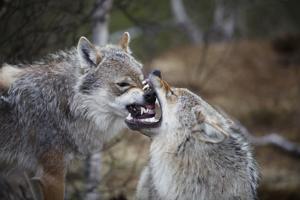Posted: Tuesday, November 18, 2014
A new study
indicates that wolves in heavily hunted areas have elevated levels of
stress and reproductive hormones. Researchers believe this can lead to
large-scale evolutionary changes and an increase in conflicts with
humans and livestock.
The study, which was published on Wednesday in the scientific journal Functional Ecology, analyzed hair samples from more than 140 wolves in heavily hunted regions in Northern Canada. Researchers discovered the wolves had higher levels of testosterone, progesterone and cortisol than wolves in regions with less hunting pressure.
The study, which was published on Wednesday in the scientific journal Functional Ecology, analyzed hair samples from more than 140 wolves in heavily hunted regions in Northern Canada. Researchers discovered the wolves had higher levels of testosterone, progesterone and cortisol than wolves in regions with less hunting pressure.
Though the study does not give
exact details of what evolutionary changes could occur over time because
of these hormone changes, researchers did say it can cause major
disruptions to the complex social structure and behavior of wolf packs.
One such disruption could be the higher birthrates per pack. “When social structure is
disrupted, multiple litters per social group become more common, in part
because dominant individuals can no longer prevent subordinates from
breeding,” the study says.
Ralph Maughan, professor emeritus
of political science at ISU, has studied public policy regarding wolves
since the species was reintroduced in Idaho during the winters of 1995
and 1996. He says studies of the effects of heavily hunted cougar
populations in Washington could reflect changes in Idaho’s wolf packs. “What happens is hunters will
kill the biggest and oldest tom cats in the pack,” he says. “The younger
tom cats who are not very experienced about things take over the pack
and raise hell. It’s possible something similar could happen in heavily
hunted wolf populations.”
Maughan says the federally
protected wolf packs in Yellowstone National Park tend to be larger and
more multi-generational than the heavily hunted packs in the park’s
neighboring states.
The smaller pack sizes can lead
to more issues with livestock. Smaller wolf packs are less likely to be
able to take down large wild game like deer and elk, so livestock
becomes easy prey as they are easier to find and kill.
This trend was reflected in Idaho Fish and Game’s 2012 annual report of the state’s wolves.
The report showed that the number
of livestock killed had increased, despite an 11 percent decrease from
the total estimated 2011 wolf population numbers.
Landowners and ranchers have
already seen the impact wolves have made on the state’s livestock
industry. According to the Department of Agriculture, wolves are
believed or confirmed to have killed 78 cattle and 565 sheep in 2013. “Smaller wolf packs need to kill
more often because their kills are often taken by scavengers, like
coyotes, magpies and ravens,” he said. “A larger wolf pack will most
likely consume their food on the spot, so proportionally, they don’t
have to kill as often.”
The study was published a day
before the announcement that four environmental groups have filed a
lawsuit to prevent a wolf and coyote hunting derby from extending onto
public BLM lands in central Idaho.
The purpose of the derby is to
thin out the state’s wolf population. But if heavily hunted wolves have
elevated reproductive hormones, as the new study suggests, what effect
will large-skill killing of wolves have on livestock and the overall
wolf population in the long term. “Hunting could increase the
fertility rate,” Maughan says. “But if the social structure is
disrupted, it could also mean the pups won’t even survive.”
source
source



No comments:
Post a Comment